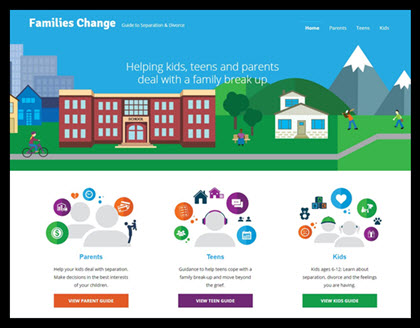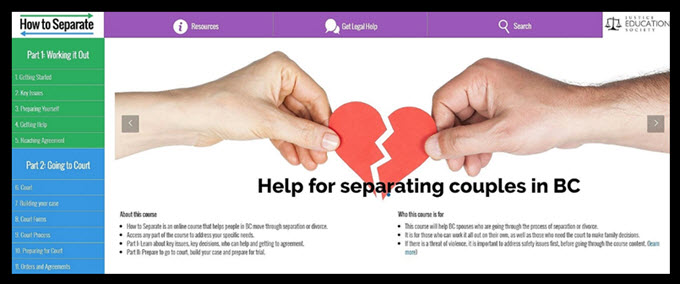Each year, 1 in 7 British Columbians gets legal help or legal education from one of the Justice Education Society’s resources or programs. Last fall the Society launched two new services to help families going through separation or divorce – an online course to coach people through the process and a national website to help both parents and kids deal with the emotional realities as well as the legal responsibilities. This eNews introduces both initiatives.
FamiliesChange.ca
A Canadian first, this website includes information geared for each age group in a family to help them deal with parents’ separation. It is national in scope, containing legal information and links to resources for each province. After you select your province you can browse one of the three guides – for parents, teens and kids.
The parents’ guide has some great information on how to tell your kids you’re separating, how to help them cope, and what you need to know about child support. In BC, you can take the online Parenting After Separation course and find resources that provide more information about the topics important to you.

The teens’ guide includes explanations of what is happening, how things may change, coping strategies, and the law governing separation and divorce. It also suggests people a teen could talk to for support. The kids’ guide contains similar information, presented in age-appropriate language. The website uses videos, graphics, Q&As and even a game called “Changeville” to convey its important information.
The Justice Education Society obtained financial support from the Supporting Families Fund of the Department of Justice Canada and worked with provincial agencies across Canada to create the website. Dave Nolette, the Society’s Digital Program Director, describes the site like this:
Teens get answers to questions like: Who decides where I live? Do I have to take sides? And kids can watch animated videos and play games with messages like: It’s not your fault; you’re not alone; and things will get better. Plus, the website provides information, videos and activities to help kids and teens deal with their new family structure.
If you are going through a separation or you know someone else going through it, tell them about FamiliesChange.ca. Everyone involved can be better prepared to deal with the challenges of a family break-up.”
Tip for using FamiliesChange.ca
First, make sure you have the right website. The Justice Education Society has created a similar site for the California Courts. If you go to FamiliesChange.ca.gov by mistake you’ll learn about California law, and it doesn’t apply here. The site you want is FamiliesChange.ca (no ‘.gov’ at the end). On the home page you select your language (English or French) and click on your province. You can then browse information for parents, teens and kids.
HowToSeparate.ca
Recognizing that separation and divorce are among the most stressful experiences anyone can have, the Justice Education Society developed HowToSeparate.ca, an online course to coach people in BC through every step in the process.
Nora Bergh, the Society’s Legal Content Specialist, explains how the course was designed, “As we developed each section, we asked: If I knew someone going through this right now, what would I tell them? What do they need to know? How can I prepare them to get through this stage?”

The result is an A to Z online course for anyone going through separation or divorce in BC, with helpful information for people recently separated as well as those deeply involved in a contested court case. To cover all this, the course is divided into two sections: Working it Out and Going to Court. You can go through the course in any order, choosing the sections that best fit your circumstances.
HowToSeparate.ca offers a series of videos with animations that help guide you through the course. All information is spoken in English, and text is written below each video. You can use Google Translate to read the content in one of 100 languages.
The course also includes a series of helpful worksheets to prepare you for each step. For example, there’s an Affidavit Checklist you can use to ensure your court documents include the necessary information.
The law and more
This website also offers help with the emotional side of separation. It teaches effective communication with your former spouse, making decisions that put your children’s interests first, and learning skills to help you reach a positive settlement.
“Separation and divorce involve a lot more than legal documents and court processes,” says Justice Education Society Executive Director, Rick Craig. “The course takes a more holistic approach. In part one of the course, we talk about the key issues you will have to work through. And we help build skills to negotiate, to communicate in high conflict situations, and to prepare you for meetings with your former spouse. Plus, it shows you where you can get help.”
Ask questions
Of course, going through separation and divorce is still going to be difficult. You will have to make difficult decisions and you may have a lot of questions. In a service called ‘Ask JES’ the site lets you ask questions by phone or live chat on weekdays between 11 am and 2 pm. At other times, you can email your family law questions to Ask JES.
Justice Education Society
The Justice Education Society is a non-profit organization dedicated to improving legal capability and increasing access to justice. The Society has produced legal web resources for every Canadian province, as well as California, Connecticut, Vermont, Maine and Ohio.
Visit FamiliesChange.ca and HowToSeparate.ca to see how they can help you.

